You will love this classic recipe for Easy Plum Jam, made with sweet, ripe, juicy plums at the height of their season. It is the ultimate way to preserve this delicious stone fruit to enjoy throughout the coming months.
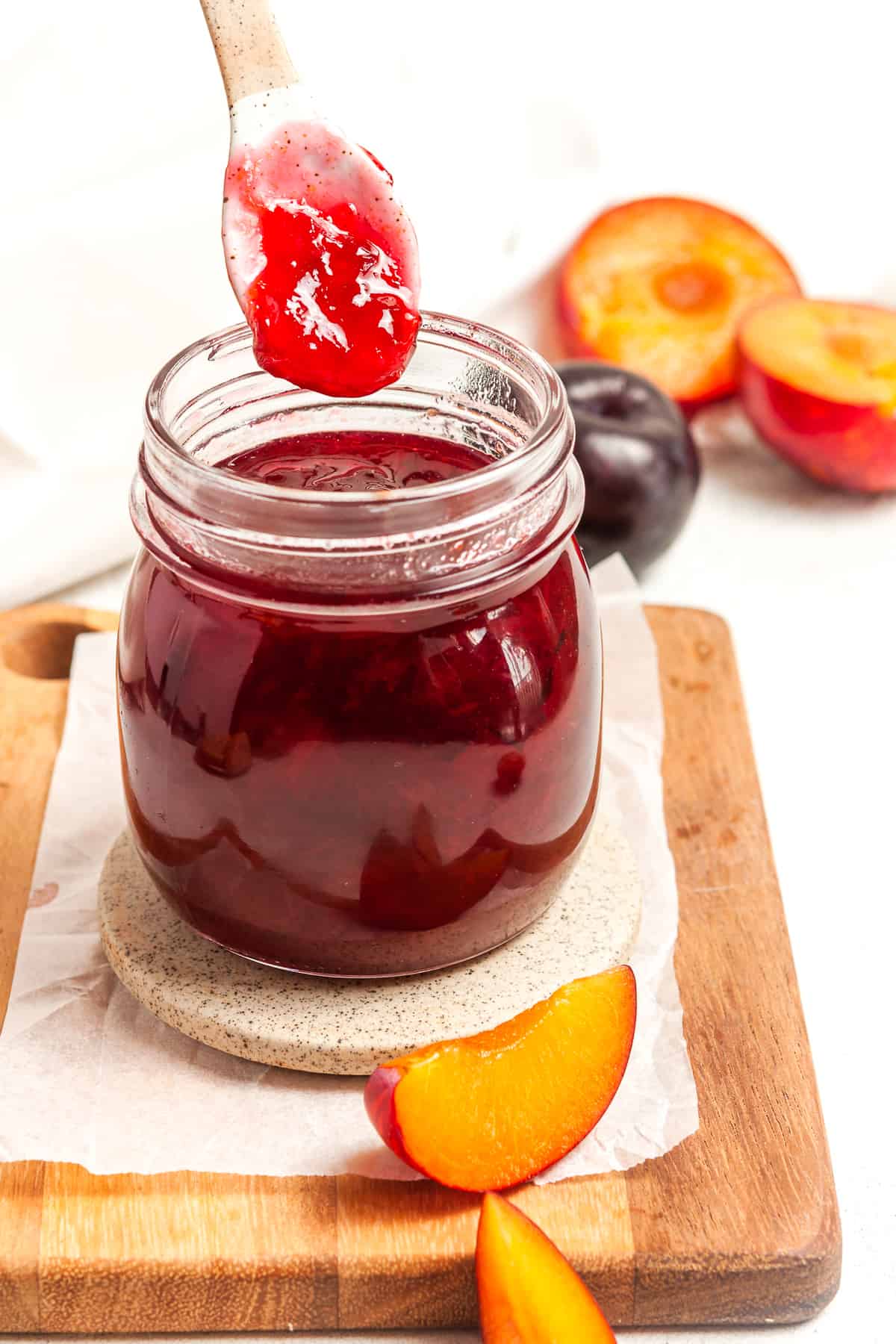
Jump to:
Why we love this recipe:
My simple, traditional recipe contains just four ingredients – plums, sugar, lemon juice and water. It does not require the addition of pectin.
In this recipe I will show you, with step-by-step instructions, how easy it is to make homemade Plum Jam.
You’ll love it because:
- Jam making is a great way to preserve some of nature’s seasonal bounty to enjoy throughout the cooler months ahead – if it lasts that long.
- Homemade jam is infinitely superior to shop-bought. There are no unwelcome additives, artificial preservatives or thickeners that you may find in a commercially prepared jam. For me, one of the most important parts of home cooking is the knowledge that I control the quality of the ingredients.
- You can use this Plum Jam in so many ways. Spread it on toast, serve with scones and cream (delicious!), make mini tarts, fill sponge cakes or drizzle over our No-Churn Vanilla Ice Cream. You are only limited by your imagination.
Ingredients in this recipe:
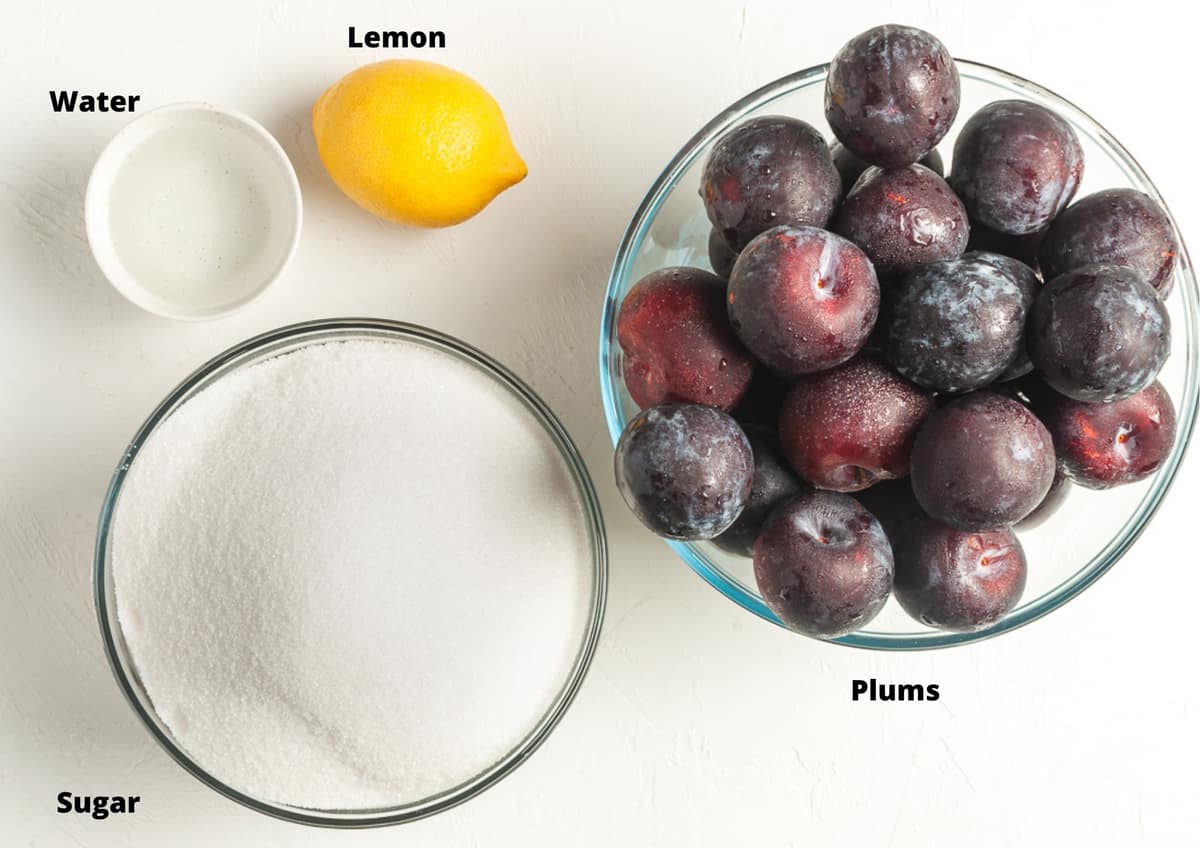
Please see the recipe card further along in the post for exact quantities of ingredients and the full method.
Plums – I often use a red plum with ruby-red flesh. It gives the jam a beautiful colour. However, you can, of course, use the plum variety of your choice, as shown below.
Sugar – regular granulated sugar is best.
Lemon juice – use freshly squeezed lemon juice. The juice is vital as it aids in the setting of the jam and balances the sweetness.
Water – filtered tap water.
Step by Step Instructions:
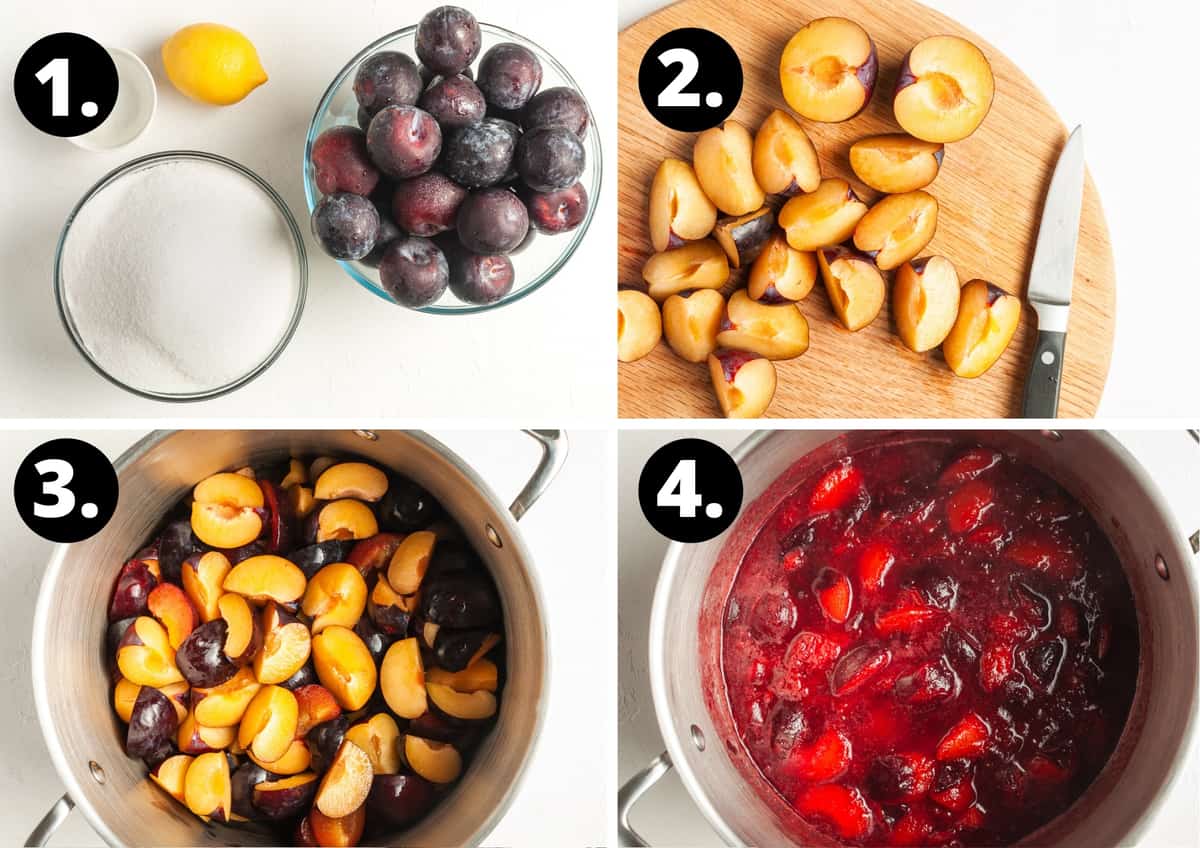
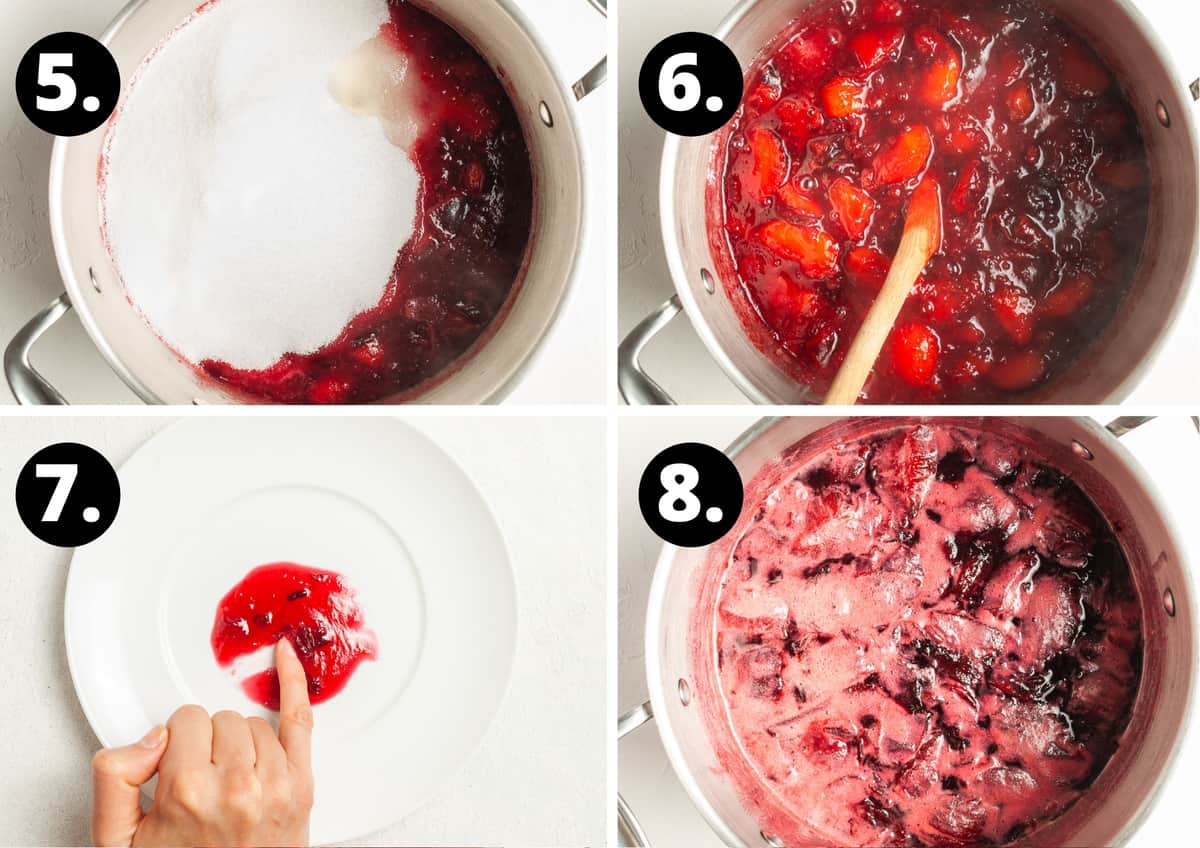
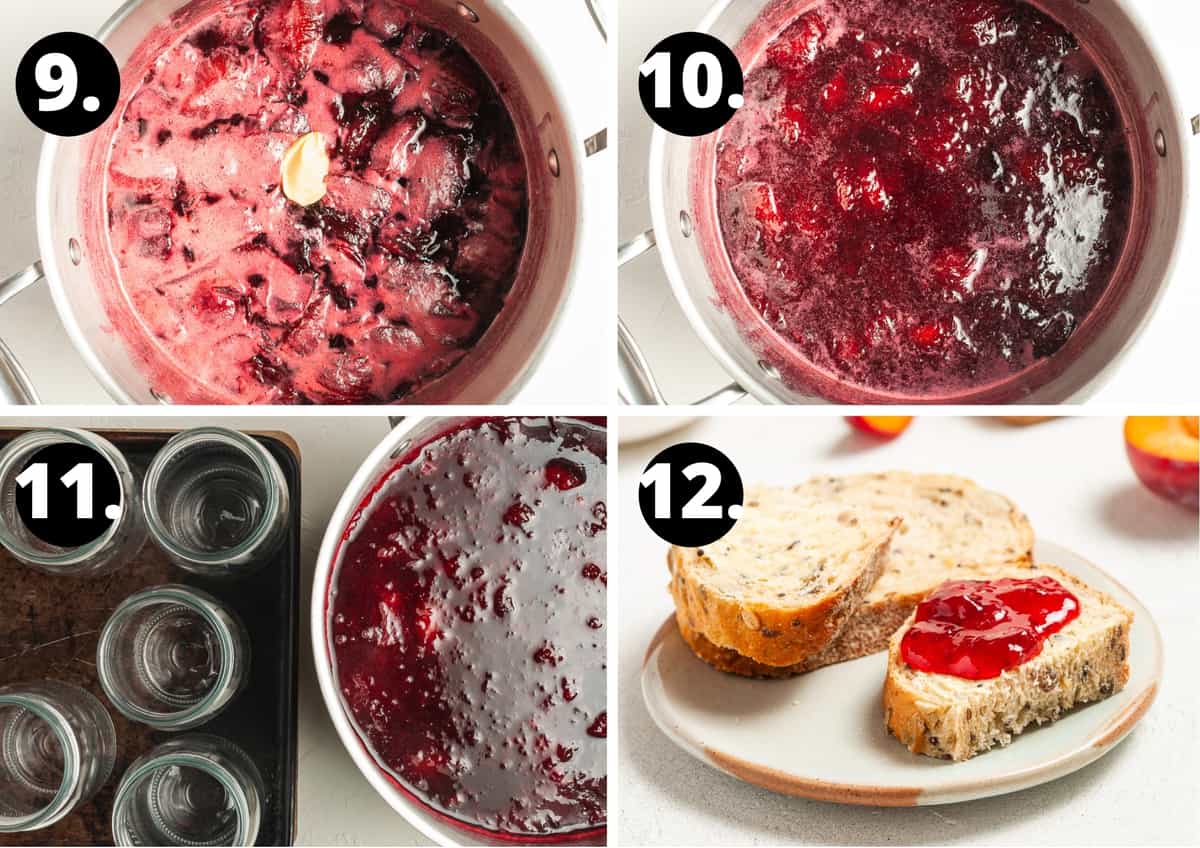
To begin, place two small saucers or plates in the freezer. You will use these to test when the jam is set.
Sterilise the jars by heating in the oven. Full directions are in the recipe below.
- Gather all of your ingredients.
- Wash the plums and remove any blemishes. Cut the fruit in half, remove the stone and cut the pieces in half again.
- Add the quartered plums, along with water, to a large, wide saucepan.
- Bring the fruit to a gentle simmer, stirring occasionally. Cook with the lid on until the fruit is soft.
- Then, add the sugar and lemon juice and stir until the sugar dissolves.
- Bring the fruit to a rolling boil, stirring frequently.
- After about 5 minutes, start to check for setting point. You will not have any trouble getting this jam to set as plums are high in pectin.
- If your jam has any scum, remove it with a spoon.
- Alternatively, add a knob of butter and stir to remove the scum.
- Allow the jam to sit for 5 minutes to allow the fruit to settle.
- When ready, ladle the Plum Jam into hot, sterilised jars and seal with the lids. After cooling, wipe the jars to remove any spills, label with the date and jam variety and store in a cool, dark place.
- Enjoy your homemade Easy Plum Jam!
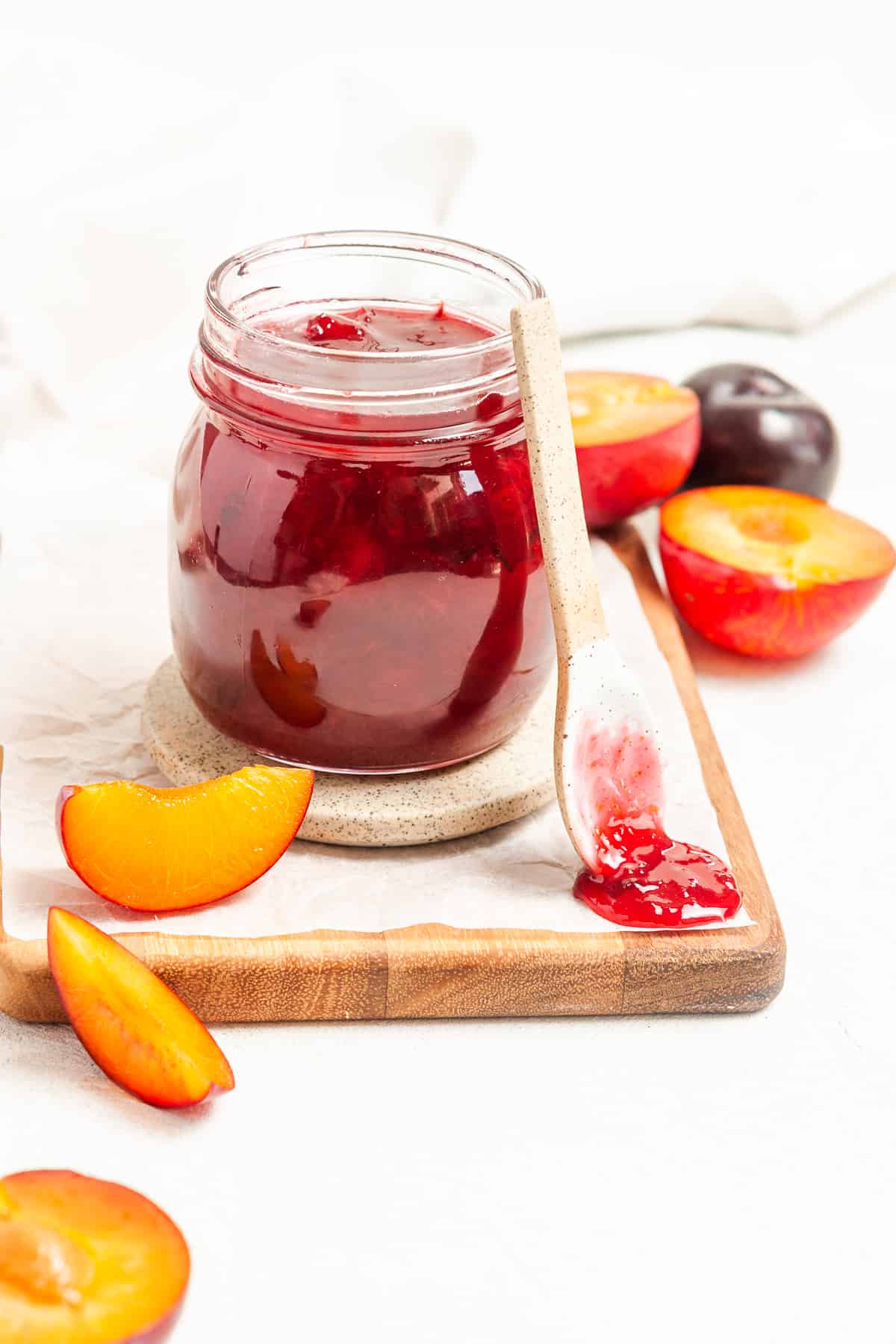
Equipment needed:
When making your own preserves, always ensure you are sterilising the jars you will store them in. This is very simple to do:
- Choose glass jars with an airtight, metal lid and ensure they have been washed in the dishwasher or by hand in hot soapy water then rinsed well.
- Check that the metal lids do not have rubber inserts, as these could melt in the oven.
- Preheat the oven to 130 Degrees C (270 F) and leave the jars for 15-20 minutes.
You can use recycled glass jars with metal lids that are in good condition or purchase new ones. Jars which have contained pickles are generally not suitable as they often hold the aroma. Save these for your own chutneys or pickles.
You will not need any special equipment to make this recipe. You need a large, wide saucepan. The large surface area allows faster water evaporation, giving the jam a concentrated flavour. Without a large saucepan, there is the risk of it boiling over.
Avoid aluminium, copper or iron pans; the acid in the fruit may react with the pan, giving the jam a metallic taste.
As well, I use a long-handled wooden spoon to keep my hand away from the bubbling jam.
Tips for success and FAQs:
Choose good quality, freshly picked fruit. Ripe plums with firm skins will contain more pectin and give the best result. Do not use plums that are over-ripe, soft or bruised as they may cause the jam to spoil.
If you follow the recipe instructions precisely and your jars are thoroughly sterilised, the Plum Jam should be shelf-stable for a year, possibly longer. No canning is required. When you open a jar, store it in the fridge. Always use a clean spoon to remove the jam.
No, you don’t need to peel the plums. The skins contain high amounts of pectin which aids with getting the jam to set.
Conventional jam requires a lot of sugar. When you see it weighed out it is slightly alarming but please don’t reduce the amount of sugar. The sugar not only sweetens the fruit but it helps the jam to set and acts as a preservative. If you reduce the sugar, your jam may not be shelf stable.
Lemon plays an important role in jam-making. It is high in acid and pectin, both essential for the setting of the jam. As well, the acidity of the lemon helps balance the sweetness.
Pectin is a naturally occurring starch that is found in varying degrees in fruits and vegetables. It is what makes jams and jellies firm when they are cool. When combined with acid and sugar, and cooked to a high temperature, it forms a gel.
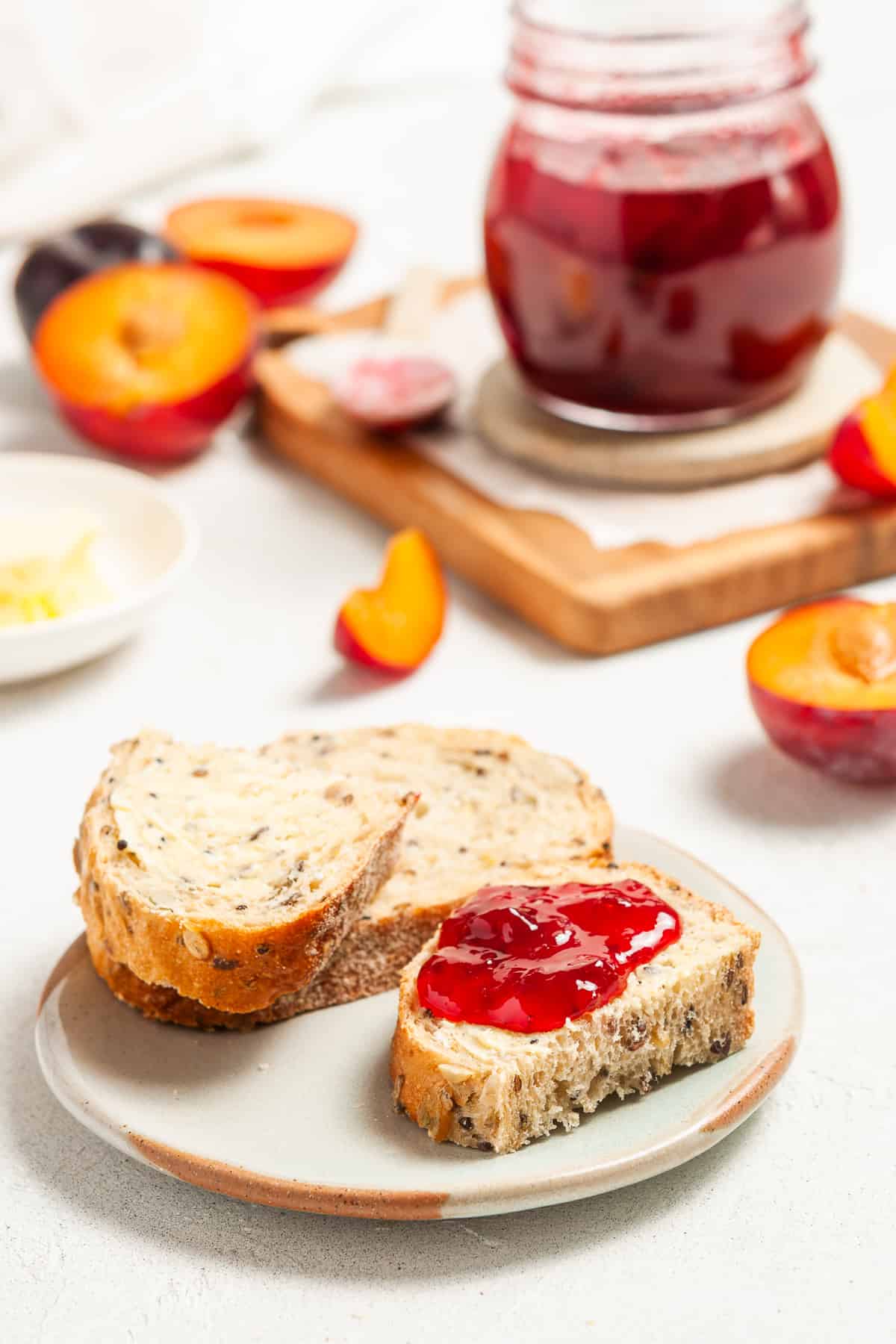
More delicious recipes for you to try:
We absolutely love making the most of in-season produce to enjoy all year round. Here are some more of our favourite preserve recipes:
- Apricot Jam
- Preserved Chillies in Oil
- Fresh Peach Chutney
- Lemon Marmalade
- Sweet Chilli Sauce
- Grapefruit Marmalade
- Blueberry Jam
My Easy Plum Jam recipe is a great place to start if this is your first time making jam as plums are high in pectin. Once you’ve perfected your jam making technique you will have the ability and equipment to make fresh jam for years to come. You just need to invest a little of your time; when you finish and see your own produce lined up, you will know that it was time well spent.
Alex xx
This post was originally published in April 2019. It has been updated with new photos and more information. The recipe remains the same.
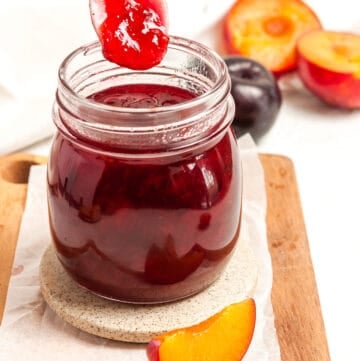
Easy Plum Jam
Equipment
- 11 x 250ml (8.5 oz) jars (See notes)
Please note:
For accuracy, when weights are provided, we recommend weighing your ingredients. This will produce the best results. All oven temperatures listed are for fan forced.
Ingredients
- 2 kg (4 ½ pounds) plums – prepared weight See Note 1
- ½ cup (125 ml) water
- 1 ½ kg (3 ⅓ pounds) granulated sugar See Notes 2 and 3
- 1 ½ tablespoon (30 ml) lemon juice See Notes 4 and 5
Instructions
To Sterilise the Jars:
- Preheat the oven to 130 Degrees C (270F).Use glass jars, either new or recycled, with an airtight, metal lid. If recycling jars, ensure that the jars do not have cracks or chips and the lids are in good condition. Discard any lids that are pitted or rusted. Ensure your lids are oven safe or see our notes if they are not. (See Note 6.)Wash the jars and lids. If washing by hand, use hot, soapy water and then rinse them well. Alternatively, wash them in the dishwasher.Place jars and lids on a baking tray. Heat in the oven for at least 20 minutes. The jars and lids should be completely dry and remain very hot.
To Make the Jam:
- Place 2 small plates or saucers in the freezer to chill – see Note 7.
- Wash the plums and remove any blemishes. To halve the plums, start at the stem end and run a sharp knife around the plum, following the naturally occurring marking. Use the tip of the knife to remove the stones.Cut the halves in half again. If you don’t want your jam to have chunks of fruit, cut the plums into eighths.
- Place the plums and water in a large, wide saucepan. See Note 8.
- Bring the plums to a simmer over low-medium heat. Stir occasionally using a long-handled wooden spoon. See Note 9.
- Cover the pot and cook, stirring occasionally, until the plums are soft, 15-20 minutes. At this stage, if you prefer less chunky jam, you could blend it using a hand-held stick blender. Take off the heat to do this.
- Add the sugar and lemon juice. Stir frequently, with the saucepan uncovered, until the sugar dissolves.
- Increase the heat and bring to a rolling boil for 5-15 minutes. You need to be vigilant at this point. Stir frequently to avoid the jam catching and burning on the bottom of the pan. Boiling time will vary depending on the size of your saucepan and the heat that you apply.
- After about 5 minutes rapid boiling, turn the heat off under the jam. Spoon a small amount of jam onto a chilled plate or saucer to check if it is starting to set. I use the wrinkle test. When the jam has cooled, push it gently with your fingertip. If it wrinkles, even slightly, it is ready. If it remains liquid, put the jam back on the heat for a further 5 minutes and check again. See Note 10.
- You can also use a thermometer to check for setting point. To use this method, you will need a sugar thermometer. Clip the thermometer to the side of your pan. When the thermometer reads 104C (220F) the jam is ready.
- When the jam reaches setting point, remove the pan from the heat. If there is any scum on the surface of the jam, add a teaspoon of butter and stir well. It will dissolve the scum.
- Let the jam stand for about 10 minutes to allow the fruit to settle. This will ensure that any pieces of fruit will be evenly distributed throughout the jam. Without standing, the fruit will rise to the top of the jar.
- The jam will still be liquid when you ladle it into your jars. It can take up to 48 hours to completely set.
- Stir the jam and carefully ladle it into the heated, sterilised jars. You need to be very careful. A splash or spill from hot jam would result in a serious burn. I recommend that you wear clothing with long sleeves. Additionally, this is not the occasion to have children nearby.Immediately seal the jars tightly with sterilised lids.
- When cool, remove any spills from the jars and label with the date and name. Store the jam in a cool, dark place. When using the jam, always use a clean, dry spoon to avoid contamination. After opening a jar, as a further precaution, store it in the refrigerator.
Notes
- Ensure your fruit is freshly picked and of good quality. Avoid fruit that is bruised or over-ripe. The plums contain pectin which aids in the jam setting. If your fruit is older, it will contain less pectin. The colour of the jam will vary depending on the variety of fruit that you use.
- My plums were perfectly ripe and sweet so I used a fruit/jam ratio of 1 kilo of fruit to ¾ kilo sugar (1 pound fruit to ¾ pound of sugar). If the fruit you use is slightly unripe and quite tart you may need to use a ratio of equal weight fruit and sugar.
- Do not reduce the amount of sugar. Whilst the sugar sweetens the fruit it also acts as a preservative and helps the jam to set. If you reduce the sugar, your jam may not be shelf-stable and may become mouldy.
- The Australian tablespoon is 20ml or 4 teaspoons. In many other countries, the tablespoon is 15ml or 3 teaspoons. Please adjust the measurement if necessary.
- Lemon juice not only balances the sweetness of the sugar, but it also contains acid and pectin which help to set the jam.
- Properly sterilising your jars is an essential process to remove bacteria that could cause your preserves to spoil. Wash the jars and lids either in the dishwasher or by hand in hot soapy water, and rinse well. Do not dry them with a tea towel. Place jars and lids on a baking tray. If you are using Kilner jars with rubber seals, be sure to remove the seals before placing the jars in the oven. The dry heat of the oven would damage the seals. Boil the seals separately in a saucepan for about 10 minutes. If your lids are not oven safe, boil them for 10 minutes and allow them to air dry. Heat the jars in the oven for at least 20 minutes. When your preserves are ready to bottle, use thick oven mitts or jar tongs to remove the jars. Do not place them on a cold surface as they may shatter. I place mine on a wooden chopping board which I cover with a tea towel. Always sterilise a few more jars than you think you will need. It is better to have too many jars than not enough.
- The chilled plates are used to quickly cool the jam when testing the setting point.
- Always choose your widest saucepan that has enough height to enable the jam to boil vigorously. More surface area means the liquid will evaporate faster; having sufficient height means you can boil the jam at a higher heat and maintain the fresh flavour of the plums. Avoid aluminium, copper or iron pans; the acid in the fruit may react with the pan, giving the jam a metallic taste.
- Do not use a metal spoon, it will become very hot. A long-handled wooden spoon is important to avoid being burnt by a splash from boiling jam.
- My jam reaches its setting point about 5 minutes after it begins to boil rapidly. Boiling time will vary depending on the size of your saucepan and the heat that you apply.
- Please note, the nutritional information is based on one whole jar. The nutritional information is an estimate only.
Nutrition Estimate:
Nutritional Disclaimer:
The nutritional information is an estimate only, and is derived from online calculators. For accurate results, we recommend calculating the nutritional information based on the ingredients and brands you use.


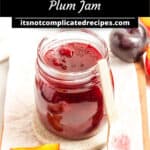
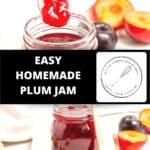
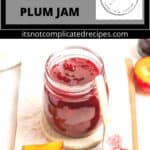
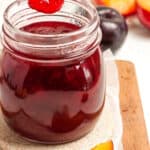
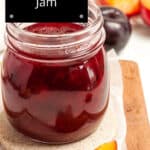
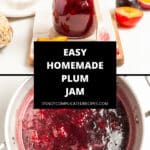
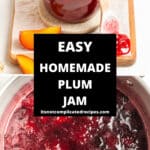
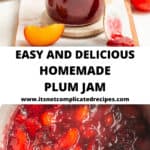
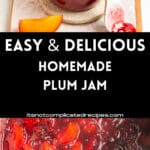
Mary Watson
Very easy to make and delicious
Alexandra Cook
Thank you, Mary 🙂
Alex xo
Christine Murray
This was my first time using this recipe ,and it was great. I prefer my jam to be chunky. Thank you very much. I have still to taste it but I am sure it will be delicious. It didn’t take long to make either.
Alexandra Cook
Thank you, Christine 🙂
I hope you’ll enjoy your jam! Thanks so much for leaving a comment.
Alex xo
Philippa
This recipe was easy and produced delicious plum jam, even with a mix of very ripe and almost ripe plums! Perfect, thank you so much!
Alexandra Cook
Thank you, Philippa!
Enjoy your jam, Alex xo
Annie
Fabulous recipe. I loved that the fruit didn’t need to be peeled. The flavor with tree ripened plums was delicious with the perfect sweet, tart flavor. I wondered how I’d feel about the skin. it melted down to nothing. I did cut them smaller on the second batch. I’m freezing the preserves.
Alexandra Cook
Thank you, Annie 🙂
I appreciate you sharing your feedback! Alex xo
Stewart
My first foray into Jam making after finding a tree full of plums at a house we moved into. Great and simple method with an even tastier result. To start with the yellow fleshed plums made the colour look a bit feral, but the pigment from the skin made the final result a deep scarlet.
Alexandra Cook
So pleased you enjoyed the recipe, Stewart!
Fantastic to have a plum tree 🙂 Thanks for taking the time to comment!
Alex xo
Erin
This came out so, so good! We went plum picking and this was the perfect use for them. I’m going to make more and freeze to enjoy it throughout the year. 🙂 Thanks!
Alexandra Cook
Thanks, Erin! 🙂 Plum picking sounds like a lot of fun.
Enjoy your jam, Alex xo
Kate
I followed the recipe to the word, it just does not set with granulated sugar…
Alexandra Cook
Hello Kate,
I am sorry to hear that you have had some issues, but I can assure you the recipe does work – in fact, several hundred people have made the recipe successfully since we published it. I don’t use pectin in any of my jam recipes, as it is just not necessary. Plums are in fact high in pectin, and with the addition of lemon juice, this jam sets easily.
Not to worry though, it may just be that your jam hadn’t reached setting point. Hopefully I can help you work out what may have gone wrong – here are a few questions:
– When did you make the jam? It can take 24-48 hours to fully set and will still be liquid when you add it to your jars.
– Were your plums lovely and fresh? If they were overripe or picked some time ago, this can affect the pectin levels.
– Did you test the setting point using the plate test and/or thermometer?
If after 48 hours your jam still hasn’t set, you can reboil it with the juice of a fresh lemon. After five minutes, test for setting point again. Add to clean, hot jars.
I hope that helps, and let me know how you get on!
Kind regards, Alex
Veronika
I found beautiful cheap plums at my farmers market this weekend and found your recipe looking for a way to use them all up. This jam is delicious and your thorough instruction really helped to make the process smooth!
Alexandra Cook
Thank you for making this recipe, Veronika!
Enjoy you jam, Alex xo
Debbie
I made six jars of your plum recipe. I am concerned that they are not sealed just making sure this is OK. The store them in the pantry or do they need to go in the refrigerator? Thank you.
Alexandra Cook
Hi Debbie,
If you have any concerns at all, you can certainly store the jars in the refrigerator, or if there is a small gap in the jars, you can freeze them (the jam will expand as it freezes, so a gap is necessary.) You can also water bath can the jars – more information here.
However, if you followed the recipe as written – with the properly sterilised jars that were hot when the jam went in, the jars will be shelf stable.
I hope that helps, and enjoy your jam 🙂 Alex xo
Linda
I am 71 and have been making jam and marmalade for many years. I found this an excellent recipe. It is explained well with lots of examples and reasons to do or not to do something. I made this jam with wild plums, red and yellow. They all turned out great. Setting point was easily reached. Thank you. I definitely recommend this recipe.
Alexandra Cook
Hi Linda,
Thank you so much for your lovely comment and feedback.
I really appreciate you taking the time to let me know. Enjoy your jam! Alex xo
Susan
Jam tastes and looks great. I did use immersion blender leaving jam a bit less chunky, but not smooth. I misunderstood the recipe though. I thought this was for freezer jam. I did sanitize my plastic screw-on lids and glass canning jars. So I’m going to treat the jam as freezer jam and put jars in the freezer until I’m ready to open another jar. I used a bit less sugar. Added lemon zest to the jam too. Thank you for this recipe and great tips too.
Alexandra Cook
Hello Susan,
Thanks for giving the recipe a try 🙂 I am so glad your jam tastes and looks great!
Appreciate your feedback, Alex xo
Debbie
I am obsessed with this plum jam !! I had a bucket if fresh plums that needed used and this was the perfect recipe. I love that you made this so easy for anyone at any cooking level .
Alexandra Cook
Hello Debbie,
Thanks so much – I am so happy you enjoyed this recipe 🙂
Alex xo
Melanie
Great recipe! Thank you! 4 batches and the tree is finally about picked out! Question on shelf life … I’ve been using canning pot after sealing jars for extra caution … is that necessary do you think? Thanks again – my go to recipe now!
Alexandra Cook
Hey Melanie!
4 batches – that is fantastic! 🙂 I am so happy that this is your go to recipe now 🙂
Thank you for reaching out 🙂
For the jam, I follow the method that my great grandma used – the hot sterilised jars and the hot jam with the lids put on immediately cause a vacuum to form a seal as they cool. As the jam has just been vigorously boiled, we don’t boil it again in a water bath. The jars are shelf-stable for 12 months, and only need to be refrigerated once they have been open.
This is a method most commonly used in Australia/UK, although I am aware that in the USA/Canada water bath canning is the more popular method.
If you prefer to water bath, you certainly can continue to do so.
Hope that helps!
Alex xo
Bob Price
I have just now used your recipe to make plum jam. I used 1 kilo organic plums but i did not use the ammount of sugar the recipe asked for. I have not bought in total a kilo of sugar in the last 50 years and never use it at home. So i used three tablespoons of Jaggery cane sugar instead of 3/4 kilo of granulated sugar. We have just spread the jam on a few crackers and it is delicious. If sugar is a preservative well it will not last long enough to go off thats for sure. This is my first attemt at jam making and i am so happy with the results, thanks.
Alexandra Cook
Hello Bob,
Thanks so much for giving the recipe a try 🙂
It sounds like you used an ideal ratio of fruit to sugar – we usually work on about a ratio of 3/4 of sugar to fruit.
I am so happy your first attempt at jam making went well and really appreciate you taking the time to let me know!
Alex xo
Jacqueline
Nothing beats homemade jam for taste! My plum jam turned out perfect. I used store bought plums but I’ll be making another batch now that my own tree has started fruiting so I can make this jam with homegrown fruit!
Alexandra Cook
This is great to hear, Jacqueline!
Thank you for sharing, Alex xo
Ashley
Besides the flavor and ease, I think what I love most about this recipe is that it doesn’t require powdered pectin (which I sometimes have trouble finding). Great recipe!
Alexandra Cook
Hi Ashley,
Thank you so much for giving this recipe a try 🙂
Happy you enjoyed the ease and flavor of the jam. Appreciate your comment!
Alex xo